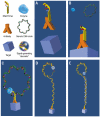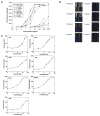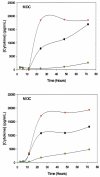Multiplexed protein profiling on microarrays by rolling-circle amplification
- PMID: 11923841
- PMCID: PMC2858761
- DOI: 10.1038/nbt0402-359
Multiplexed protein profiling on microarrays by rolling-circle amplification
Abstract
Fluorescent-sandwich immunoassays on microarrays hold appeal for proteomics studies, because equipment and antibodies are readily available, and assays are simple, scalable, and reproducible. The achievement of adequate sensitivity and specificity, however, requires a general method of immunoassay amplification. We describe coupling of isothermal rolling-circle amplification (RCA) to universal antibodies for this purpose. A total of 75 cytokines were measured simultaneously on glass arrays with signal amplification by RCA with high specificity, femtomolar sensitivity, 3 log quantitative range, and economy of sample consumption. A 51-feature RCA cytokine glass array was used to measure secretion from human dendritic cells (DCs) induced by lipopolysaccharide (LPS) or tumor necrosis factor-alpha (TNF-alpha). As expected, LPS induced rapid secretion of inflammatory cytokines such as macrophage inflammatory protein (MIP)-1beta, interleukin (IL)-8, and interferon-inducible protein (IP)-10. We found that eotaxin-2 and I-309 were induced by LPS; in addition, macrophage-derived chemokine (MDC), thymus and activation-regulated chemokine (TARC), soluble interleukin 6 receptor (sIL-6R), and soluble tumor necrosis factor receptor I (sTNF-RI) were induced by TNF-alpha treatment. Because microarrays can accommodate approximately 1,000 sandwich immunoassays of this type, a relatively small number of RCA microarrays seem to offer a tractable approach for proteomic surveys.
Figures





References
-
- Leuking A, et al. Protein microarrays for gene expression and antibody screening. Anal. Biochem. 1999;270:103–111. - PubMed
-
- de Wildt RMT, Mundy CR, Gorick BD, Tomlinson IM. Antibody arrays for high-throughput screening of antibody–antigen interactions. Nat. Biotechnol. 2000;18:989–994. - PubMed
-
- MacBeath G, Schreiber SL. Printing proteins as microarrays for high-through-put function determination. Science. 2000;289:1760–1763. - PubMed
MeSH terms
Substances
Grants and funding
LinkOut - more resources
Full Text Sources
Other Literature Sources
Medical
Research Materials

